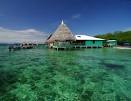Kayaking on the Chesapeake Bay
Kayaking will not save your soul or bring world peace, but it will move you from youth through the middling years and onward to wisdom. We’re talking about kayak touring, not the rough and tumble white water sport that gets all the headlines and warnings.
Flat water or sea kayaks are long, stable craft, built to cut through swells and withstand wind. There are other sports suitable for the aging weekend athlete who wants to preserve physical dignity and prowess, but kayaking can’t be beat for visual rewards.
The views are better from a long stable kayak where you sit on a comfortable seat, legs outstretched below deck and feet braced on pegs that connect to the kayak’s rudder. (Not all flat water kayaks have rudders.) During the summer, I usually paddle without the spray skirt, but it’s necessary when Bay chop is sweeping the boat deck or afternoon thundershowers catch you still out. No one can bail or pump accumulating water when you also clutch a double blade paddle. A lifejacket, cockpit skirt cover, bailing pump, whistle and light are essential equipment.

On flat water, found in the numerous inlets, rivers and tributaries of the Eastern Shore of Maryland or Southern Maryland, the land between the Potomac River and the Bay, the paddling effort is slight. You can drift with the river current.
The Choptank and Tuckahoe Rivers water trail is particularly lovely. When I’m out paddling the serpentine tributaries of the Chesapeake Bay watershed, I often think of the native First Peoples of the region. The Native peoples of the Chesapeake region

can inform modern caretakers of our waterways.
Dip, swush, dip, swush…. Paddle cadence simulates a moving meditation, a soothing zen system for approaching the universe. Suddenly a Great Blue

rises from a burned out tree, wing span long nearly as long as the kayak. A turtle claps into the water, a beaver dives beneath the water. Overhead Canada geese fly formation and there, out of the corner of my eye, a carp burns its yellow belly in the sun drenched surface of the river. If it is evening, and a more secluded watershed, perhaps a deer will be nibbling on tree leaves, ghosting the end of the day, marking it in my memory for all time.
Boating excursions from St. Michael’s area and beyond:

During the 1930s, Pres. Roosevelt, (Franklin D.) visited the hunter’s clubhouse on the four-mile spit of land as a nearby weekend retreat. The name honors the poplar trees on the island. The island has been undergoing restoration for years. Dredged material has restored the island nearly to the perimeters of 1847.
South Marsh Island in Tangier Sound is under the Maryland Department of Natural Resources Wildlife & Heritage Service.
Smith Island, Maryland is famous for its cake. That’s right, Smith Island Cake is like none other. The locals serve a mean crab cake too. Board the ferry at Crisfield, Md.
Tilghman Island, Maryland offers the easy going Bay lifestyle with rental apartments for weekenders from Edge City urban areas.
Tangier Sound – If you’re out kayaking on this water, seek local information about currents and tides. Bear in mind there are rip currents both ways and possibly, motor boats piloted by well-oiled weekend day-sailors with impaired vision for kayakers ahead.
Watts Island off Tangier Island, Virginia might be too isolated for kayaking excursions.
Watch for mid to late afternoon winds which churn up the water and make paddling a strenous activity. Keep your eye on shoreline landmarks such as towers or buildings to measure your progress. If you’re not moving forward, make a new heading, possibly angling to shore. You can’t beat wind force + currents with mere muscle.
Kayak memories are soft. The sun at day’s end, the moon on black water, reeds rustling, nutria and muskrats scurrying away. Fish slapping the water surface with a force that can only be interpreted as glee when they realize that long shark-like creature isn’t a predator.
Resources:
Maryland Online Boating Access Guide









